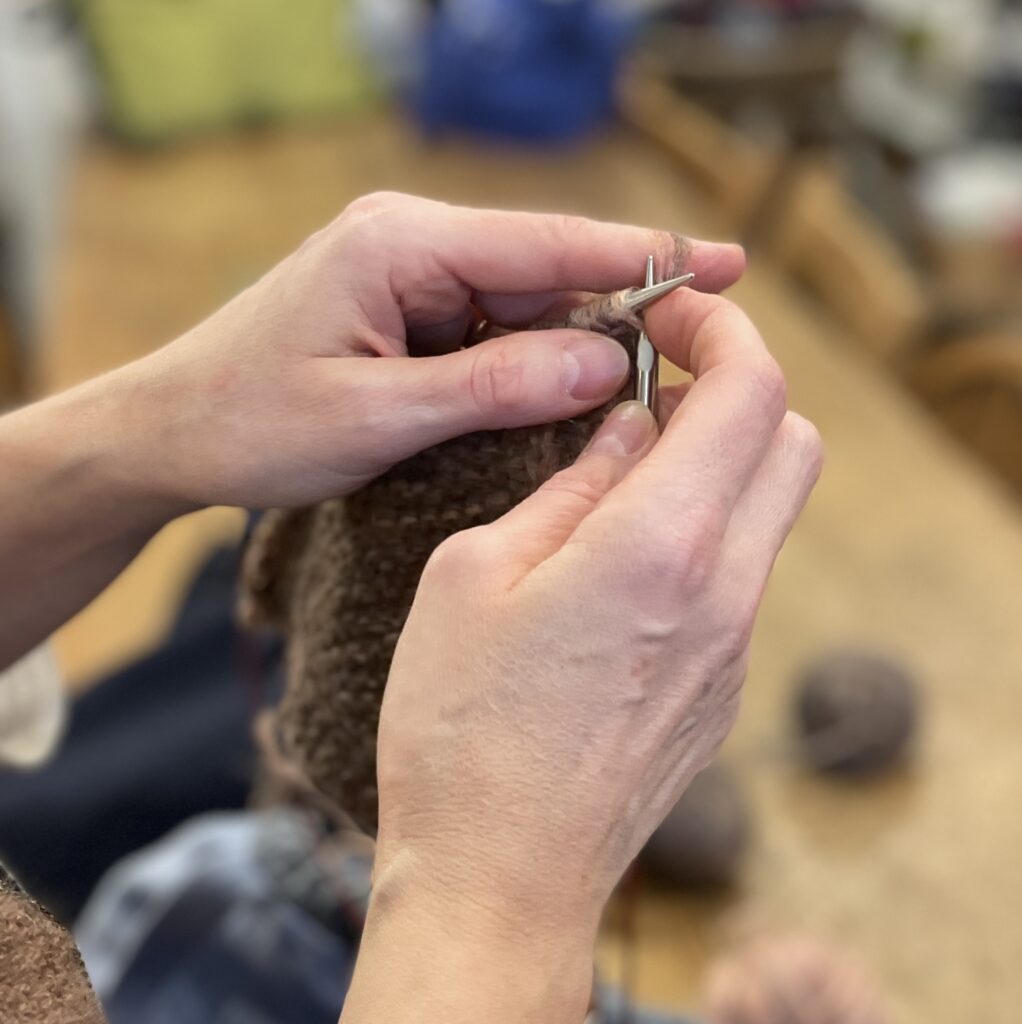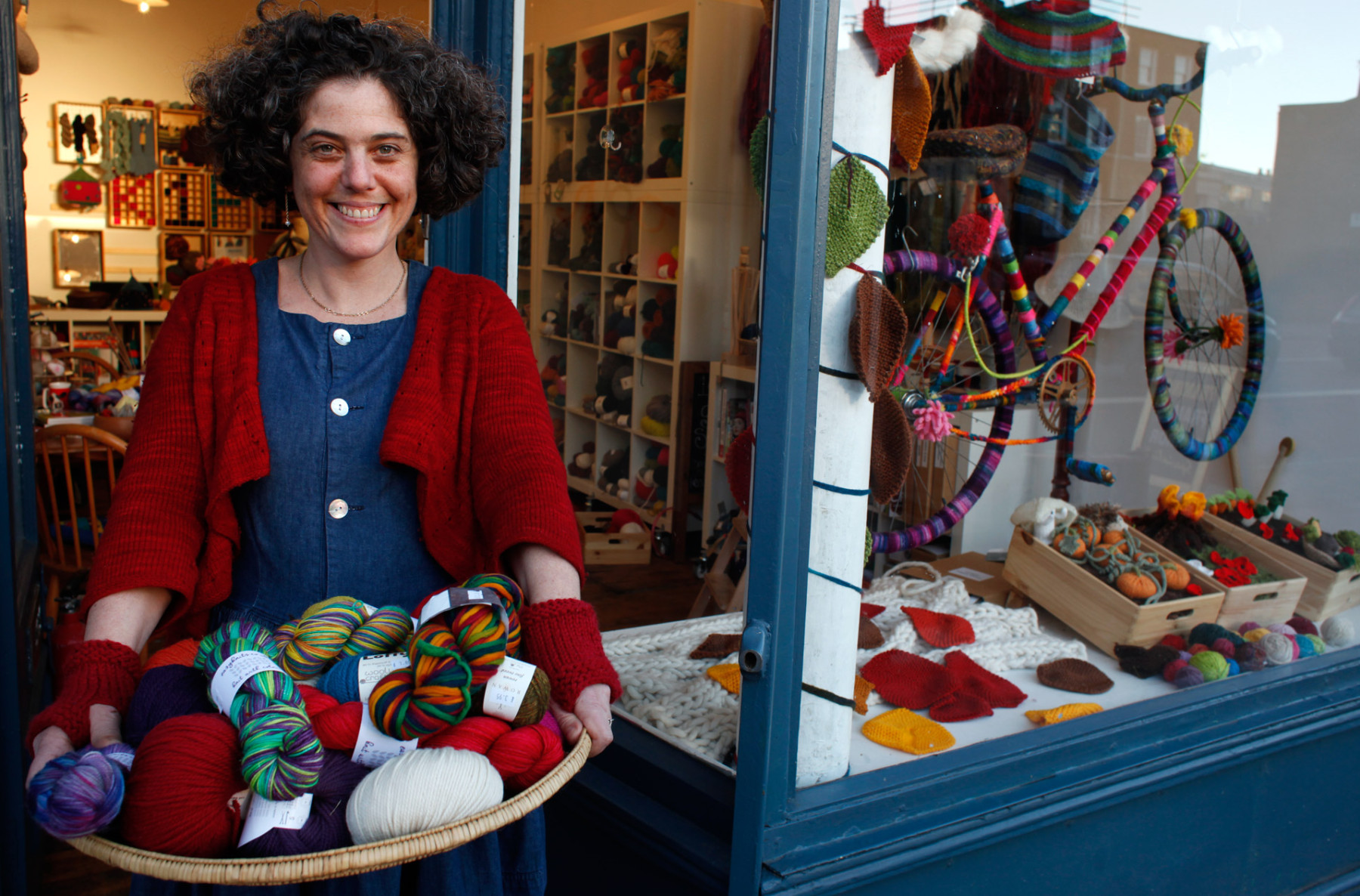The Manchelopis arrives here in large, shiny black plastic tightly wrapped bundles that put me in mind of the bales you see wrapped in the fields after haymaking in the summer. It comes that way because the 100g plates of yarn are so voluminous in comparison to normal 100g balls or skeins of yarn, that our standard 15kg order can’t fit in a regular tea-crate box. We call it yarn, but in truth it’s more of a pre-yarn, that has been carded but not twisted. The result is knitting wool that contains more air than fibre and that feels light as a cloud and makes a soft and pillowy fabric which is unbelievably warm

Now if all that big, softy-soft light-as-a-feather stuff is the first thing to notice about Manchelopis, the very next thing, is that it’s also super-fragile. Just a gentle tug on the un-knitted yarn will pull it apart. That’s why most conversations we have about Manchelopis, involve showing knitters just how easy it is to mend the breaks – all it takes is a rub in the normal heat and moisture of your hands to fuse the ends back together.
We are plainly in niche yarn territory here, and as people who are already a bit of a way along the niche spectrum, you could say that unspun yarn just takes us a couple of babuskas deeper into the Russian dolls version of our pastime. But never mind the niche-ness, we still need to know how to knit with it and what it’s good for. So I’ve called on the help of a fabulous knitter with an almost unsurpassed unspun knitting repertoire. If anyone can explain how best to knit with Manchelopis, I feel sure that Heleanna Lenti Palumbo is the one.
I start by asking her for tips to give someone who’s afraid about the yarn breaking. She pauses, stares at a nowhere point in the distance and appears to be thinking really hard. Now I’m confused. Isn’t this the bit where she just shows me how easy it is to rub the yarns together? Why is she so deep in thought?
‘I asked Caroline about this‘ she says eventually, referring to the doyen of unspun yarn, and the woman behind Nutiden, a legendary unspun yarn made at a micro mill in Sweden..
“She just said, ‘Relax and twist the yarn once before you start – all it takes is trusting the yarn and letting go of the control’…and then I realised this is like learning about life and yourself while you knit, and how to relax along the way. And this is true every time I knit with unspun yarn.“
Heleanna continues, “It’s not about your speed. Don’t wrap it around your fingers. Hold it gently. You turn it lightly around the needle and then you let go. It’s about your mindset.. That’s why I love it – because sometimes I feel that I have to let go.. This is like life.. You have to adjust your tension.. I go up and down with my moods. It helps me.. It’s a dialogue and it’s really reminded me about life. Sometimes you go through stuff and you realise I just need to let go. With unspun wool that’s what works.”
It dawns on me that I have just inadvertantly pulled on a thread I had no idea was in my hands. But now that Heleanna is unravelling it, I just need to see where it goes..
Does this mean you need to be really engaged with the knitting?
“Not really [she pauses and considers the question at bit more]. No. Well, it depends what you want to knit.. The thing is that you need a different tension in your hands. The brain can do that. It learns to adjust the tension. You grow into it. You become more aware of it and you know what to do. And then it’s just a matter of choosing the right needle size and holding the yarn close to the needle.”

Heleanna continues in this way fusing together the emotional work done by the wool, with the steps that your hands need to take to make the fabric happen, so that not only does the difference between the two seem to evaporate, but I’m also left wondering why I’ve thought of them separately until now.
“The breaking can be liberating,” she says. “At the beginning you might get stressed about it. But we all need to learn to be more patient. When you have too much on your mind, the yarn breaks all the time. That’s when I say you just need to step away and let go.
Heleanna stops and then adds, “And the amazing thing is that you don’t need to weave in your ends. There’s this beautiful thing which is that you have such a neat fabric at the end, with no idea of where the breaks were.“
With huge (airy and voluminous) thanks to Heleanna for all her help in making this post possible.
For anyone looking for unspun yarn projects, Heleanna recommends the following:
Shawls:
Soft Focus by Samantha Guerin
Flourish Shawl by Ravijennaknits
Nivalis scarf by Teti Lutsak
Mutsch by Isabell Kraemer who interestingly also writes “Working with unspun yarn is an experience in itself. We need to calm down and relax and take care not to work with a tight tension (the yarn breaks easily).“
Sweaters:
Dropp by Ailbíona McLochlainn – a classic design
Laneus Pullover by Teti Lutsak (there are also a matching shawl and hat)
Kume Sweater and Kume Cardigan by Vanessa Pellisa
Wild Posy by Melody Hoffman
Paul Klee Sweater by Midori Hirose
Vests:
Lastlong Tank by Ailbíona McLochlainn
Cutting Edge Vest by Ailbíona McLochlainn
Glint Vest by Irene Lin

